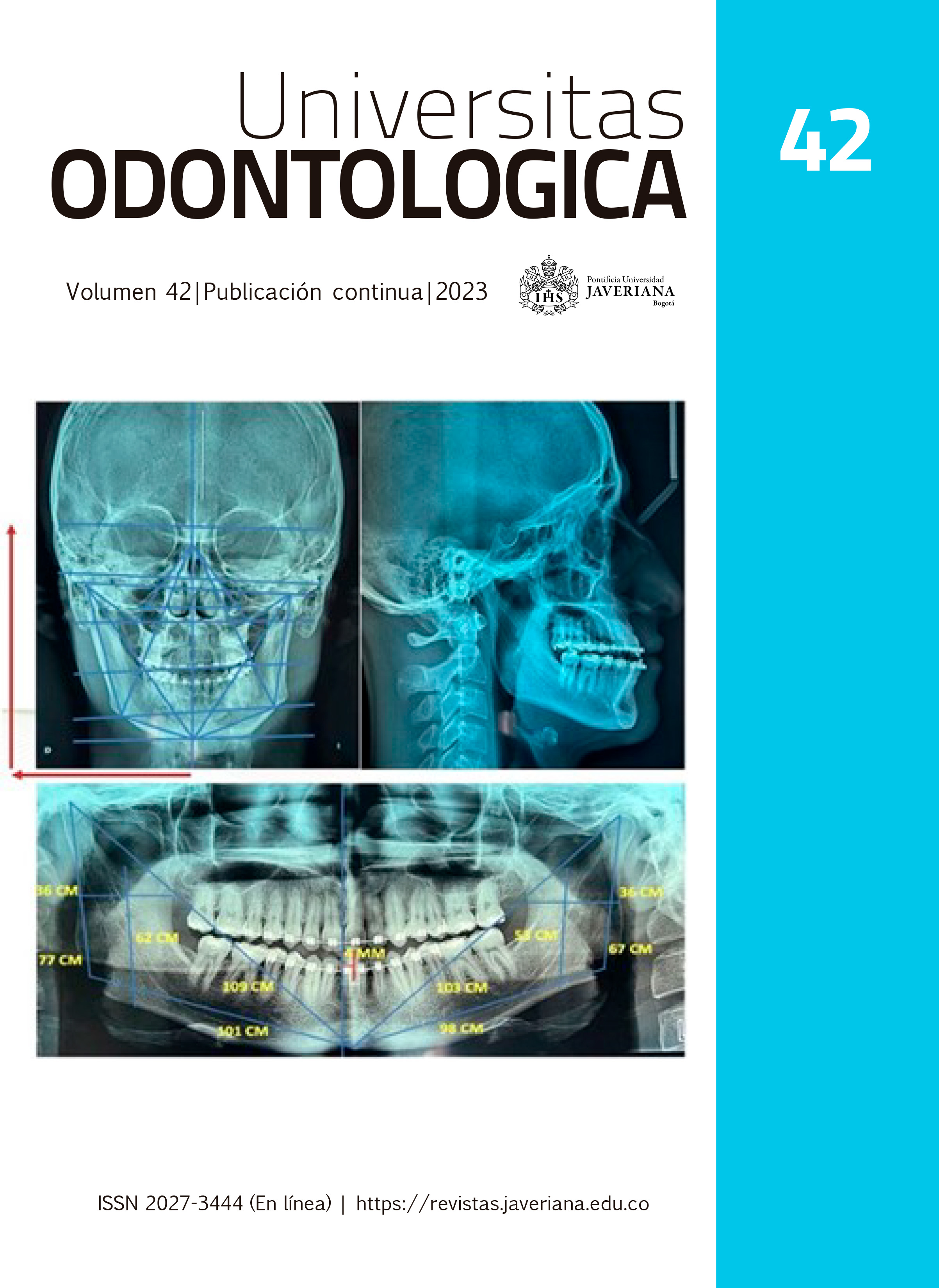Abstract
Background: A wide range of functional devices allow stimulating mandibular growth in class II patients, through mandibular advancement; managing to correct this type of skeletal and occlusal disharmony. Fixed repositioning appliances apply constant forces to the TMJ and may cause remodeling of the articular condyle and glenoid fossa. Computed tomography (CT) has been the gold standard for imaging the bone and hard tissues of the TMJ, but today cone beam computed tomography (HCCT) and Nuclear Magnetic Resonance (MRI) are used, because of their low and zero levels, respectively, of radiation. Objective: to measure morphological changes through TMJ imaging evaluation after correction of class II malocclusion with functional treatment with appliances in growing patients Methods: a comprehensive systematic literature search was conducted from January 2015 to May 2023 in the following bibliographic databases PubMed, EBSCO, Embase, and the Cochrane Library. Results: 10 studies were selected. The total sample size was 210 patients, and the age range was 10.3 to 14 years. The main imaging method used was HCCT with n = 9. Conclusions: The main change described is condylar remodeling, followed by morphological adaptation of the fossa. Although no significant differences have been reported in morphological changes in the TMJ between fixed versus removable functional appliances, fixed appliances cause a higher incidence of morphological changes.
Cozza P, Baccetti T, Franchi L, De Toffol L, McNamara JA Jr. Mandibular changes produced by functional appliances in Class II malocclusion: a systematic review. Am J Orthod Dentofacial Orthop. 2006 May; 129(5): 599.e1-12; discussion e1-6. https://dx.doi.org/10.1016/j.ajodo.2005.11.010
Atresh A, Cevidanes LHS, Yatabe M, Muniz L, Nguyen T, Larson B, Manton DJ, Schneider PM. Three-dimensional treatment outcomes in Class II patients with different vertical facial patterns treated with the Herbst appliance. Am J Orthod Dentofacial Orthop. 2018 Aug; 154(2): 238-248.e1. https://dx.doi.org/10.1016/j.ajodo.2017.11.037
González FK, Lazo AY, LLanes RM. Syndrome type II division 2 malocclusions and temporomandibular dysfunction. Invest Medicoquir. 2020; 12(1): 1-18.
Kinzinger GSM, Lisson JA, Booth D, Hourfar J. Are morphologic and topographic alterations of the mandibular fossa after fixed functional treatment detectable on tomograms? Visual classification and morphometric analysis. J Orofac Orthop. 2018 Nov; 79(6): 427-439. English. https://dx.doi.org/10.1007/s00056-018-0156-y
Bhat Zeeshan I, Naik C, Rahalkar J. Early Intervention in Skeletal Class II and dental Class II division I malocclusion. APOS Trends in Orthodontics.2013; 3: 121. https://dx.doi.org/10.4103/2321-1407.117380
Nishanth B, Gopinath A, Ahmed S, Patil N, Srinivas K, Chaitanya ASK. Cephalometric and computed tomography evaluation of dentoalveolar/soft-tissue change and alteration in condyle-glenoid fossa relationship using the PowerScope: A new fixed functional appliance for Class II correction –A clinical study. Int J Orthod Rehabil. 2017; 8(2): 41. https://dx.doi.org/10.4103/ijor.ijor_5_17
Kyburz KS, Eliades T, Papageorgiou SN. What effect does functional appliance treatment have on the temporomandibular joint? A systematic review with meta-analysis. Prog Orthod. 2019 Aug 12; 20(1): 32. https://dx.doi.org/10.1186/s40510-019-0286-9
Watted N, Witt E, Kenn W. The temporomandibular joint and the disc-condyle relationship after functional orthopaedic treatment: a magnetic resonance imaging study. Eur J Orthod. 2001 Dec; 23(6): 683-693. https://dx.doi.org/10.1093/ejo/23.6.683
Souki BQ, Vilefort PLC, Oliveira DD, Andrade I Jr, Ruellas AC, Yatabe MS, Nguyen T, Franchi L, McNamara JA Jr, Cevidanes LHS. Three-dimensional skeletal mandibular changes associated with Herbst appliance treatment. Orthod Craniofac Res. 2017 May; 20(2): 111-118. https://dx.doi.org/10.1111/ocr.12154
Elfeky HY, Fayed MS, Alhammadi MS, Soliman SAZ, El Boghdadi DM. Three-dimensional skeletal, dentoalveolar and temporomandibular joint changes produced by Twin Block functional appliance. J Orofac Orthop. 2018 Jul;79(4): 245-258. English. https://dx.doi.org/10.1007/s00056-018-0137-1
Gandedkar NH, Shrikantaiah S, Patil AK, Baseer MA, Chng CK, Ganeshkar SV, Kambalyal P. Influence of conventional and skeletal anchorage system supported fixed functional appliance on maxillo-mandibular complex and temporomandibular joint: A preliminary comparative cone beam computed tomography study. Int Orthod. 2019 Jun; 17(2): 256-268. https://dx.doi.org/10.1016/j.ortho.2019.03.008
Jiang YY, Sun L, Wang H, Zhao CY, Zhang WB. Three-dimensional cone beam computed tomography analysis of temporomandibular joint response to the Twin-block functional appliance. Korean J Orthod. 2020 Mar;50(2):86-97. https://dx.doi.org/10.4041/kjod.2020.50.2.86
Wei RY, Atresh A, Ruellas A, Cevidanes LHS, Nguyen T, Larson BE, Mangum JE, Manton DJ, Schneider PM. Three-dimensional condylar changes from Herbst appliance and multibracket treatment: A comparison with matched Class II elastics. Am J Orthod Dentofacial Orthop. 2020 Oct; 158(4): 505-517.e6. https://dx.doi.org/10.1016/j.ajodo.2019.09.011
Fan Y, Schneider P, Matthews H, Roberts WE, Xu T, Wei R, Claes P, Clement J, Kilpatrick N, Penington A. 3D assessment of mandibular skeletal effects produced by the Herbst appliance. BMC Oral Health. 2020 Apr 16; 20(1): 117. https://dx.doi.org/10.1186/s12903-020-01108-4
Nindra J, Sidhu MS, Kochhar AS, Dabas A, Valletta R, Rongo R, Spagnuolo G. Three-Dimensional Evaluation of Condyle-Glenoid Fossa Complex Following Treatment with Herbst Appliance. J Clin Med. 2021 Oct 15; 10(20): 4730. https://dx.doi.org/10.3390/jcm10204730
Parvathy RM, Shetty S, Katheesa P. Evaluation of changes seen in TMJ after mandibular advancement in treatment of Class II malocclusions, with functional appliances, a CBCT study. Biomed (Trivandrum). 2021; 41(2): 236-242. https://doi.org/10.51248/.v41i2.789
Shetty V, Shetty K. Evaluation of skeletal changes in mandibular ramus height, corpus length, and mandibular angle changes following twin block appliance therapy using cone-beam computed tomography: A clinical prospective study. Int J Orthod Rehabil. 2021; 12(3): 115. https://doi.org/10.4103/ijor.ijor_3_21

This work is licensed under a Creative Commons Attribution 4.0 International License.
Copyright (c) 2023 Jordi Tomàs Aliberas, Catalina Pizarro Lavin, Dídac Sotorra Figuerola, Natalia Felipe Spada


